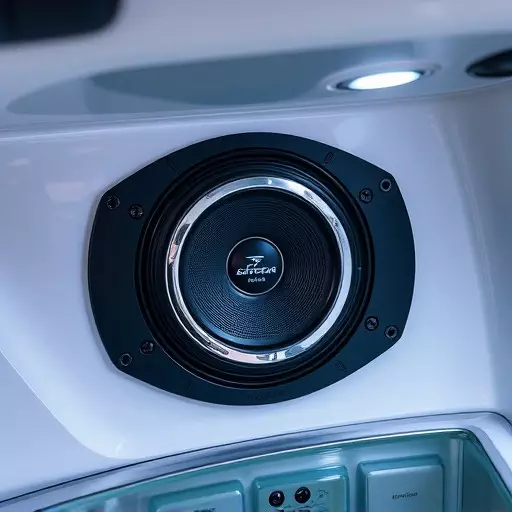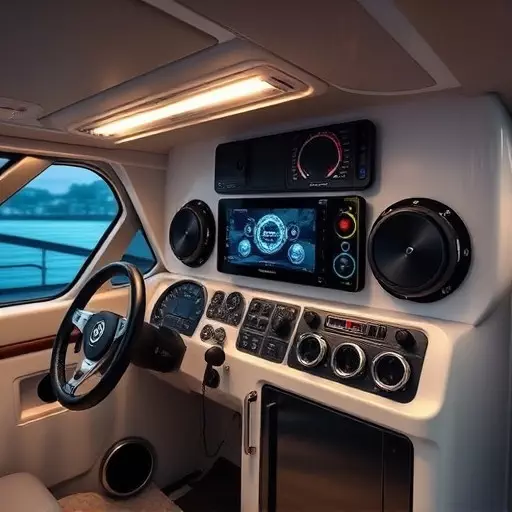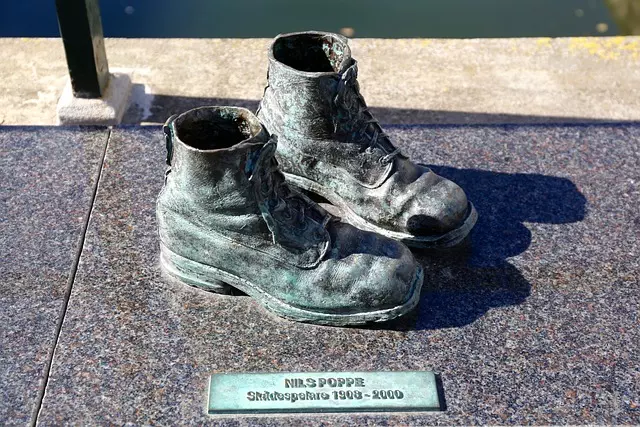Marine audio systems require specialized components and expertise to withstand salt water corrosion, extreme temperatures, and vibrations. Toledo offers professional services with waterproof speakers, corrosion-resistant wiring, marine-grade amplifiers, and tailored subwoofers for optimal performance. Choosing right speakers, waterproofing, strategic placement, and regular maintenance are key. DIY installations require thorough understanding of audio equipment and boat mechanics while professionals guarantee precise work and customized solutions, enhancing sailing experiences and safety.
“Elevate your time on the waves with high-fidelity marine audio setups—a game-changer for boat owners seeking an immersive soundscape. This comprehensive guide explores the intricacies of creating a superior audio experience aboard. From understanding essential components to selecting the perfect speakers and waterproofing measures, we cover it all. Learn about professional vs DIY marine audio installation techniques and best practices tailored to various boat types. Discover how subwoofers, amplifiers, and regular maintenance can optimize your maritime sound journey.”
- Understanding Marine Audio Systems: Components and Requirements
- Choosing the Right Speakers for Optimal Sound Quality in Water Environments
- The Importance of Waterproofing: Protecting Your Audio Equipment
- Installation Techniques for Marine Audio: Professional vs DIY Approach
- Best Practices for Positioning Speakers in Different Boat Types
- Enhancing Sound Experience with Subwoofers and Amplifiers in Maritime Settings
- Maintenance Tips for High-Fidelity Marine Audio Systems
Understanding Marine Audio Systems: Components and Requirements

Understanding Marine Audio Systems: Components and Requirements
Marine audio installation goes beyond simply selecting high-quality speakers and amplifiers. It involves a comprehensive understanding of the unique challenges posed by the marine environment, including salt water corrosion, extreme temperatures, and vibrations from waves and engines. In Toledo, professional marine audio installation services play a crucial role in ensuring optimal sound quality and system longevity.
A top-tier marine audio setup typically includes specialized components designed to withstand these conditions. This may comprise waterproof speakers, corrosion-resistant wiring, marine-grade amplifiers, and subwoofers tailored for limited space and swaying motions. DIY enthusiasts might opt for a more basic installation, but professional setup offers enhanced performance, reliability, and peace of mind, making it a preferred choice for those seeking the best audio experience on their boat.
Choosing the Right Speakers for Optimal Sound Quality in Water Environments

Choosing the right speakers is a critical step in achieving optimal sound quality for any marine audio installation, whether it’s a DIY project or a professional setup in Toledo. In water environments, special considerations come into play due to the unique challenges posed by salt water corrosion and the impact of humidity. Look for speakers designed specifically for marine use, often made with waterproof materials and robust construction to withstand these conditions.
When selecting speakers, focus on models that offer wide frequency response, high sensitivity, and good sound dispersion. These features ensure that music or audio signals are reproduced accurately across a broad range of frequencies, filling the space with rich, clear sound. Additionally, consider the physical dimensions and mounting options suitable for your vessel to guarantee proper integration without compromising sound quality.
The Importance of Waterproofing: Protecting Your Audio Equipment

When installing a high-fidelity marine audio system, waterproofing is paramount. Saltwater and moisture can wreak havoc on delicate electronics, leading to costly repairs or replacements. A proper marine audio installation in Toledo, whether DIY or handled by professionals, must address this challenge head-on. Using waterproof connectors, sealing all gaps, and treating components with protective coatings are essential steps to safeguard your investment from the corrosive effects of saltwater environments.
Professional marine audio installers understand the unique challenges posed by marine settings. They have access to specialized tools and materials designed for underwater applications, ensuring a more secure installation that can withstand the rigors of boating life. For those considering a DIY approach, investing in waterproof components and learning proper sealing techniques is crucial to prevent damage and ensure your marine audio setup delivers pristine sound quality for years to come.
Installation Techniques for Marine Audio: Professional vs DIY Approach

When it comes to installing a high-fidelity marine audio setup, there are two primary approaches: professional installation and DIY (do-it-yourself). Each method has its advantages and considerations.
Professional marine audio installation offers unparalleled expertise and precision. Marine audio specialists utilize specialized tools and techniques tailored for the unique challenges of marine environments, such as salt water corrosion and vibration from waves. They ensure optimal sound quality, seamless integration with your vessel’s systems, and peace of mind knowing that the job is done right. DIY installations, while potentially saving costs, require a deep understanding of audio equipment and boat mechanics. It involves careful planning, precise measurements, and proper wiring to avoid common issues like feedback, poor sound projection, or short circuits in wet environments.
Best Practices for Positioning Speakers in Different Boat Types

When it comes to installing high-fidelity marine audio systems, positioning speakers correctly is paramount for optimal sound quality. In smaller boats or yachts with limited space, consider using compact speakers strategically placed around the vessel. Mounting them on the bulkheads or under seats can create a immersive stereo effect without taking up precious room. For larger vessels, such as cruisers or fishing boats, a more robust setup might be required. Here, professional marine audio installation experts can help design a custom layout, utilizing main deck speakers for direct listening and strategically placed surround speakers to enhance the overall audio experience.
In terms of placement, avoid mounting speakers directly over water or in areas prone to direct sunlight as these conditions can negatively impact sound quality and equipment longevity. Instead, opt for shaded locations or use protective enclosures where possible. Additionally, ensuring proper spacing between drivers is crucial to prevent interference and feedback. A general rule is to maintain a distance at least equal to the diameter of each driver, allowing for clean, uninterrupted sound reproduction. Whether you’re tackling a DIY marine audio installation in Toledo or seeking professional help, understanding these best practices will ensure your boat’s audio system delivers the high-fidelity experience you deserve while out on the open water.
Enhancing Sound Experience with Subwoofers and Amplifiers in Maritime Settings

In maritime settings, enhancing sound experiences goes beyond standard audio installations. The unique environment poses challenges like noise from engines, wind, and waves, which can distort or mask desired audio signals. This is where specialized components like subwoofers and amplifiers come into play. Subwoofers, with their powerful bass output, help fill in the low-frequency gaps often obscured by sea noises. High-quality marine amplifiers, designed to withstand harsh conditions, amplify these signals without distorting them, ensuring a clear and rich sound even amidst chaos.
Professional or DIY marine audio installation techniques are crucial for optimizing these components’ performance. Proper placement of speakers and subwoofers, along with careful routing of cables, ensures minimal interference from water, salt air, and vibrations. A well-executed marine audio installation in Toledo, OH, or anywhere on the water, can transform a mundane sailing experience into an immersive journey where music, podcasts, or navigation systems are heard distinctly, enhancing safety and enjoyment alike.
Maintenance Tips for High-Fidelity Marine Audio Systems

Maintaining a high-fidelity marine audio system is crucial for ensuring optimal sound quality while cruising. Regular cleaning and inspection are key components of upkeep. Saltwater corrosion can be particularly damaging, so it’s essential to use appropriate materials and techniques during installation. For instance, choosing marine-grade hardware and wiring specifically designed to resist corrosion is vital. Additionally, sealing connectors and enclosure gaps with waterproof seals helps prevent moisture intrusion.
Over time, components may require replacement or recalibration. Professional marine audio installation services can provide expert advice on best practices and recommended maintenance intervals. DIY enthusiasts should refer to manufacturer guidelines for specific care instructions, particularly regarding speakers, amplifiers, and transducers. Regular cleaning of speaker cones with deionized water and soft cloths helps maintain clarity and prevents buildup of salt deposits, ensuring the system continues to deliver a vibrant, high-fidelity listening experience on the open sea.


